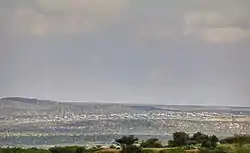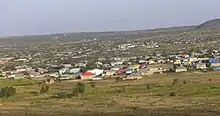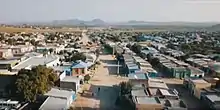Awbare
Awbare (Amharic: ጠፈር በር, Somali: Aw Barre), officially known as Teferi Ber[1] and called after its patron Saint Awbare,[2] is a town in eastern Ethiopia located in the Fafan Zone of the Somali Region, near the border with Somaliland on the main trade route between Jijiga and the sea. It is the administrative center or the capital of Awbare.
Awbare
Aw Barre Teferi Ber ጠፈር በር | |
|---|---|
City | |
 Awbare (Teferi Ber) | |
 Awbare Location within Ethiopia | |
| Coordinates: 9°47′N 43°13′E | |
| Country | |
| Region | Somali Region |
| Zone | Awbare (woreda), Faafan Zone |
| Elevation | 1,551 m (5,089 ft) |
| Population (2005) | |
| • Total | 35,977 |
| Time zone | UTC+3 (EAT) |
It was one of the biggest towns of the Adal Empire.[3][4] According to Ethiopian Christian folklore, this town was the only gateway that has caused fear for the Ethiopian Christian Kingdom, hence the name Teferi Ber, meaning "The Gate of Fear".[5]
The main trade route between Jijiga and the sea passes through Awbare; an ancient route to Zeila almost always went through Awbare. In 1962 it was described as a dry weather road. The Ethiopian News Agency reported in early 1998 that much khat was illegally smuggled out of Ethiopia by this route.[6]
When emperor Haile Selassie inspected the region in 1935 prior to the outbreak of the Second Italo-Ethiopian War, Haile Selassie made a secret two-day excursion to Awbare.[6] The Italian Giuda described Awbare in 1938 as a Somali village with about 1,000 inhabitants, whose houses were partly built of masonry, and possessing a mosque; a little to the west of the village was the tomb of the patron Saint Awbare.[7]
G.W.B. Huntingford noticed that whenever a historic site had the prefix Aw in its name (such as the ruins of Awbare), it denoted the final resting place of a local Saint.[8]
History

Awbare is one of the oldest inhabited cities in Ethiopia, known as Teferi Ber [1] which in Amharic denotes the name of Ras Tafari Makonnen's (Ge'ez ልጅ፡ ተፈሪ፡ መኮንን) Gate of Fear, a threat for the Abyssinian Empire during the peak of power for the Muslim State of Adal.[5] Awbare was one of the biggest cities of the former Adal Empire. It is the final resting place of Sheikh Awbare whose tomb is located west of the town. Both the tombs of the celebrated patron Saints Awbare and Awbube are much frequented and under the protection of the local Gadabuursi Dir clan who dominate the region in which they are buried.[9] Awbare was the seat of one branch of the Gadabuursi Ugasate/Sultanate family (Reer Ugaas) that emerged during the colonial period. Many of the Gadabuursi traditional leaders and kings were from this town, such as Ugaas Rooble Ugaas Nuur (buried near the town), Ugaas Cabdi Ugaas Rooble (who was crowned leader during the Italian occupation of Ethiopia), Ugaas Rooble Ugaas Doodi (Ugaas Rooble III) and many others. The Ugaas on the Abyssinian side of the border around Awbare and the Hararghe region was known as Dejazmach (ደጃዝማች ) or 'Commander of the Gate'.[10][11]
Old Town of Awbare


Awbare is situated over 1,000 m above sea level. The old town contained over 200 houses, each built with stone walls and mason ranging from single room to multi-roomed courtyard houses. Niches were cut in the walls for storage, and they were roofed with brushwood laid over wooden rafters. The mosques were built much more ambitiously.[12]
Richard Francis Burton (1856) describes the old ruined town upon visitation as he passed by, in his book First Footsteps in East Africa:
"Without returning the salutations of the Bedouins, who loudly summoned us to stop and give them the news, we trotted forwards in search of a deserted sheep-fold. At sunset we passed, upon an eminence on our left, the ruins of an ancient settlement, called after its patron Saint, Ao Barhe: and both sides of the mountain road were flanked by tracts of prairie-land, beautifully purpling in the evening air."[13]
Demographics
The town is inhabited by the Gadabuursi subclan of the Dir clan family. With the majority of the inhabitants belonging to the Faarah Nuur, one of the two sub divisions of Reer Nuur, a clan of the Makahiil Gadabuursi.[14] The town also has a sizeable population of the Reer Ugaas subclan of the Makayl-Dheere branch of the Makahiil Gadabuursi.[15]
The Department of Sociology and Social Administration, Addis Ababa University, Vol. 1 (1994), describes the Awbare district as being predominantly Gadabuursi. The journal states:
"Different aid groups were also set up to help communities cope in the predominantly Gadabursi district of Aw Bare."[16]
Filipo Ambrosio (1994) describes the Awbare district as being predominantly Gadabuursi whilst highlighting the neutral role that they played in mediating peace between the Geri and Jarso:
"The Gadabursi, who dominate the adjacent Awbare district north of Jijiga and bordering with the Awdal Region of Somalia, have opened the already existing camps of Derwanache and Teferi Ber to these two communities."[17]
Based on figures from the Central Statistical Agency in 2005, Awbare of 35,977 inhabitants 18,978 are men and 16,999 are women.[18] The 1997 census reported this town had a total population of 24,125 of whom 12,538 were men and 11,587 women. 1994 Population and Housing Census of Ethiopia: Results for Somali Region, Vol. 1 Tables 2.4, 2.13 (accessed 10 January 2009). The results of the 1994 census in the Somali Region were not satisfactory, so the census was repeated in 1997.
Education
Awbare has many schools. One of the most famous being Sheikh Hassan Nuriye Primary and Intermediate school.
Notable residents
- Ugaas Rooble Ugaas Nuur (buried in Awbare).
- Ugaas Cabdi Ugaas Rooble (crowned in Awbare).
- Ugaas Rooble Ugaas Doodi (Rooble III).
- Sheikh Hassan Nuriye (buried in Awbare).
Notes
- Teferi Ber is the name used by the Central Statistical Agency in its Agricultural Sample Enumeration 2001-2002 (1994 E.C.): Report on Area and Production - Somali Region Archived 2008-11-20 at the Wayback Machine
- I.M. Lewis (1998). Saints and Somalis: Popular Islam in a Clan-based Society. p. 90. ISBN 9781569021033.
- Saints and Somalis: Popular Islam in a Clan-based Society
- , (accessed 25 December 2010)
- Magaaladda Aw-Barre Archived 2011-07-26 at the Wayback Machine, source in Somali (accessed 12 October 2010)
- "Local History in Ethiopia, Tefaw Lezer - Teru" Archived 2007-09-27 at the Wayback Machine The Nordic Africa Institute website (accessed 20 March 2009)
- "Local History in Ethiopia, Asta Dega - Azzazzo" Archived 2008-02-28 at the Wayback Machine The Nordic Africa Institute website (accessed 20 November 2007)
- Huntingford, "The town of Amud, Somalia", Azania, (1978)
- Nur, Sheikh Abdurahman 1993 "Ilbaxnimadii Adal Iyo Sooyaalkii Soomaaliyeed: The Renaissance of Adal Somali history". 1993.
- Nur, Sheikh Abdurahman 1993 "Ilbaxnimadii Adal Iyo Sooyaalkii Soomaaliyeed: The Renaissance of Adal Somali history". 1993.
- Feyissa and Hoehne, Dereje, Markus (2007). "Resourcing State Borders and Borderlands in the Horn of Africa" (PDF). Max Planck Institute for Social Anthropology.
- , The archaeology of Islam in sub-Saharan Africa (accessed 20 December 2010)
- Burton, Richard (1856). First Footsteps in East Africa (1st ed.). Longman, Brown, Green, and Longmans.
Without returning the salutations of the Bedouins, who loudly summoned us to stop and give them the news, we trotted forwards in search of a deserted sheep-fold. At sunset we passed, upon an eminence on our left, the ruins of an ancient settlement, called after its patron Saint, Ao Barhe: and both sides of the mountain road were flanked by tracts of prairie-land, beautifully purpling in the evening air.
- Hayward, R. J.; Lewis, I. M. (2005-08-17). Voice and Power. Routledge. p. 136. ISBN 9781135751753.
The major town and region of the Rer Farah Nur, Aw Baare.
- "Information on the situation of Gadabursi clan members in Gebileh in, north west of Somalia". 1994.
the Rer Ugas, mostly in Ethiopia around Aw Bare (also called Teferi and West.
- "Sociology Ethnology Bulletin of Addis Ababa University". 1994.
Different aid groups were also set up to help communities cope in the predominantly Gadabursi district of Aw Bare.
- "Theoretical and Practical Conflict Rehabilitation in the Somali Region of Ethiopia" (PDF). 2018–2019. p. 8.
The Gadabursi, who dominate the adjacent Awbare district north of Jijiga and bordering with the Awdal Region of Somalia, have opened the already existing camps of Derwanache and Teferi Ber to these two communities.
- CSA 2005 National Statistics, Table B.4